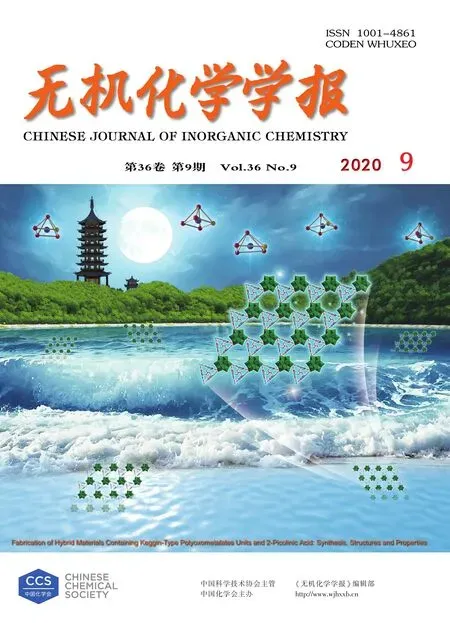含Keggin类型多酸单元和2-吡啶甲酸的杂化材料的合成、结构及表征
2020-09-10曹阳政曾祥华张俊勇郭海洋廖金生刘遂军谢景力
曹阳政 徐 昊 潘 伟 曾祥华 张俊勇*,郭海洋 廖金生 刘遂军 谢景力*,
(1江西理工大学化学化工学院,赣州 341000)
(2嘉兴学院生物与化学工程学院,嘉兴 314001)
(3吉林大学化学学院,无机合成与制备化学国家重点实验室,长春 130012)
(4中国科学院福建物质结构研究所,结构化学国家重点实验室,福州 350002)
Polyoxometalates(POMs)are discrete anionic metal oxygen clusters and they exhibit a great diversity of sizes,nuclearities and shapes[1-2].This kind of materials have attracted widespread attention because they show great potential in the realm of information technology,energy and environment[3-5].Specifically,several recent examples have shown their candidacy for future application in:(1)information technology,where the POMs cluster containing[(Se(Ⅳ)O3)2]4-central unit could be oxidized to a[Se(Ⅴ)2O6]2-moiety with a{Se(Ⅴ)-Se(Ⅴ)}bond,resulting in a promising molecule for memory devices because of its characteristic“write-onceerase”[6];(2)energy,where the clusters Na5[H3Pt(Ⅳ)W6O24](PtW6O24)and Na3K5[Pt(Ⅱ)2(W5O18)2](Pt2(W5O18)2)exhibit higher electrocatalytic activity for hydrogen evolution reaction(HER)compared with metallic Pt0[7];(3)environment,where supramolecular assembly consisting of POMs clusters and cationic organic hosts to achieve novel liquid separation membranes for many liquids,and the separation efficiency of both hydrophobic and hydrophilic liquids could reach over 99%[8].
Notably,with their versatial structural characters,inorganic-organic hybrid complexes containing POMs units and organic ligands are a valuable class of compounds since they could be used in the fields of catalysis,magnetism,electrochemistry,etc[9].Recently,several kinds of POMs-based compounds with different organic ligands have been reported by our laboratory[10-12].Following this research line,2-picolinic acid(2-PA)has been selected to combine with POMs unit to achieve hybrid materials.2-PA,the derivative of pyridine with a carboxylic acid substituent at the 2-position,could provide potential coordination sites with its-N,-Oatoms.In this contribution,it has been integrated with Keggin-type[SiW12O40]4-and [PMo12O40]3-units to achieve final products:H2[(CH3)4N]6[Cu(2-PA)2(SiW12O40)2](1)and(H3O)[Cu6(2-PA)9(PMo12O40)(NO3)](2).
1 Experimental
1.1 Reagents and general techniques
All the chemicals were received as reagent grade and used without any further purification.IR spectra were recorded from solid samples palletized with KBr on a Varian 640 FT/IR spectrometer in a range of 4 000~450 cm-1.Powder X-ray diffraction(PXRD)patterns collected on a DX-2600 spectrometer with MoKαradiation(λ=0.071 073 nm)at 293 K(Voltage:40 kV,Current:30 mA,Scan range:0°~60°).
1.2 Synthesis of H2[(CH3)4N]6[Cu(2-PA)2(SiW12O40)2](1)
A mixture of Cu(NO3)2·3H2O (241.6 mg),H4[SiW12O40](200 mg),2-PA(123 mg)and 10 mL water was stirred at room temperature.The pH value was adjusted to 3.5 with 3.0 mol·L-1HNO3,then the suspension was transferred to a Teflon-lined reactor and kept under autogenous pressure at 160℃for 3 days.After slow cooling to room temperature,blue cubic crystals were filtered and washed with distilled water(Yield:48%,based on Cu).IR(KBr,cm-1):3 571(m),3 037(w),1 642(m),1 481(m),1 359(m),1 015(m),972(vs),924(vs),886(vs),794(vs),534(s).Anal.Calcd.for C36H82CuN8O84Si2W24(%):C,6.65;H,1.27;N,1.72.Found(%):C,6.22;H,1.05;N,1.70.
1.3 Synthesis of(H3O)[Cu6(2-PA)9(PMo12O40)(NO3)](2)
A mixture of Cu(NO3)2·3H2O (241.6 mg),(NH4)6Mo7O24·4H2O(100 mg),2-PA(123 mg),0.2 mL H3PO4and 10 mL water was stirred at room tempera-ture.The pH value was adjusted to 0.5 with 3.0 mol·L-1HNO3,and then the suspension was transferred to a 25 mL Teflon-lined reactor and kept under autogenous pressure at 160℃for 3 days.After slow cooling to room temperature,green cubic crystals were filtered and washed with distilled water(Yield:68%,based on Cu).IR(KBr,cm-1):1 642(w),1 620(w),1 595(w),954(w),924(vs),805(m),689(w).Anal.Calcd.for C54H39Cu6Mo12N10O62P(%):C,19.17;H,1.16;N,4.14.Found(%):C,19.01;H,1.35;N,4.21.
1.4 X-ray crystallography
Single crystal X-ray diffraction analysis data for compounds 1 and 2 were collected with an Oxford Diffraction Gemini R Ultradiffractometer with graphitemonochromated MoKα(λ=0.071 073 nm)radiation at 293 K.Then,the structures were solved by direct methods and refined onF2by full-matrix least-squares methods using the SHELXTL package[13-14].The hydrogen atoms attached to carbon atoms were placed at geometrically estimated positions.A summary of the crystal data and structure refinements of compounds 1 and 2 is provided in Table 1 and the selected bond lengths and angles are given in Table 2.
CCDC:1978845,1;1978846,2.

Table 1 Crystal data and structure refinements for compounds 1 and 2
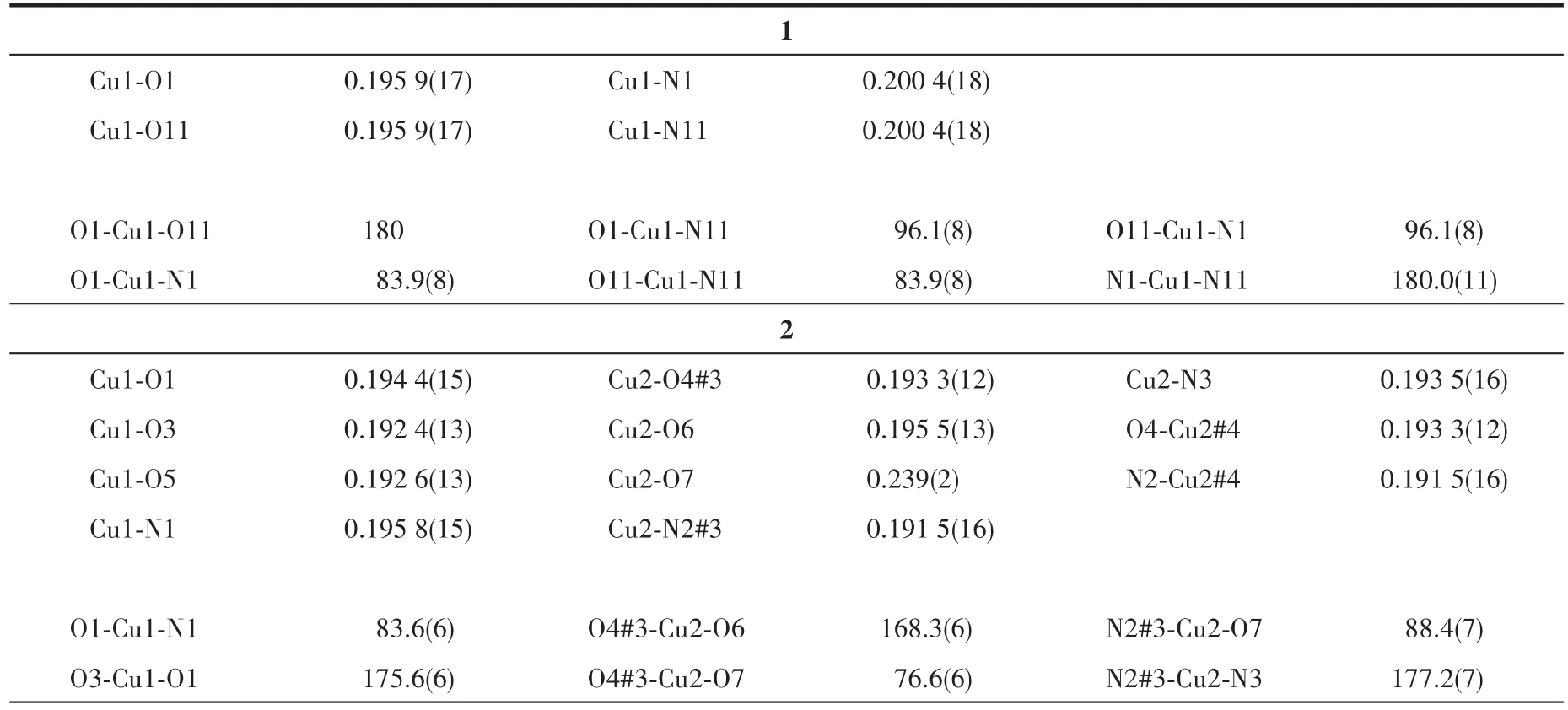
Table 2 Selected bond distances(nm)and bond angles(°)for 1 and 2

Continued Table 1
2 Results and discussion
2.1 Structural description of compound 1
X-ray single crystal diffraction analysis reveals that compound 1 is a zero-dimensional(0D)structure.It crystalizes in monoclinic system with space groupP21/c.The asymmetric unit is composed of one Cu(Ⅱ)ion,two 2-PA ligands and two[SiW12O40]4-Keggin-type polyoxometalate anions.The bond valence calculation shows that the Si atoms are in+4 oxidation state,all the W atoms are in+6 oxidation state,and the Cu atoms are in+2 oxidation state[15].As for the coordination mode of the Cu,the coordination oxygen atoms in the axial direction are from two different[SiW12O40]4-POMs units(Fig.1a).Based on the six-coordinated situation,an octahedral structure is fulfilled(Fig.1b).The bond lengths of Cu-O bond and Cu-N bond are in a range of 0.195 9(17)~0.250 9(14)nm and 0.200 4(18)nm,respectively.

Fig.1 (a)Structure of compound 1;(b)Octahedron configuration of Cu ion
2.2 Structural description of compound 2
Compound 2 crystallizes in trigonal system with space groupR3c,and bond valence sum calculations[15]show that all molybdenum atoms are in+6 oxidation state,phosphorus atom is in+5 oxidation state,and Cu atoms are in+2 oxidation state.There are two crystallographically independent Cu(Ⅱ)ions with two kinds of coordination modes(Fig.2).Cu1 is coordinated by one N atoms from 2-PA ligand,three O atoms from three 2-PA ligands and one O atom from PMo12polyoxoanion,showing a distorted quadrilateral cone configuration[CuN1O4](Fig.2b).Cu2 is five-coordinated by two N atoms from two 2-PA ligands,two O atoms from two 2-PA ligands and one O from NO3-anion to exhibit a distorted quadrilateral cone configuration [CuN2O3](Fig.2c).The bond lengths of Cu-O bond and Cu-N bond are in a range of 0.192 4(13)~0.239(2)nm and 0.191 5(16)~0.195 8(15)nm,respectively(Table 2).
Adjacent six Cu(Ⅱ)ions are linked by 2-PA ligands and nitrate group,forming a hexanuclear cluster.In the hexanuclear cluster,three Cu2 ions are bound together via nitrate group to form a Cu3(NO3)triangle.Similarly,three Cu1 ions form a larger triangle by the Cu3(NO3)triangle and 2-PA ligands(Fig.3a).Each PMo12is wrapped by three hexa-nuclear clusters to form a three-leaf fan shape(Fig.3b).There is right-handed helical chain presented in compound 2(Fig.3c)and furthermore,the hexauclear cluster are linked together to form a two-dimensional(2D)network(Fig.3d).
During the crystallographic analysis of POMs clusters,it is generally easy to identify unambiguously the heavy atoms such as Mo and W,but very often it is hard to locate counter cations because of inherent crystallographic disorder issues.The situation becomes worse for the lighter atoms such as N and C.As for compound 1,it is good to see the exact position of the[(CH3)4N]+cations could be identified and located unambiguously.To keep the charge balance,two isolated protons is included in the structure because of the acidic experimental condition.As for compound 2,to keep the charge balance,the isolated hydronium is included in the structure[16].
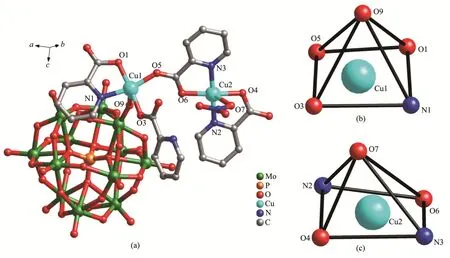
Fig.2 (a)Asymmetric unit of compound 2;(b,c)Coordination environment of Cu1 and Cu2,respectively
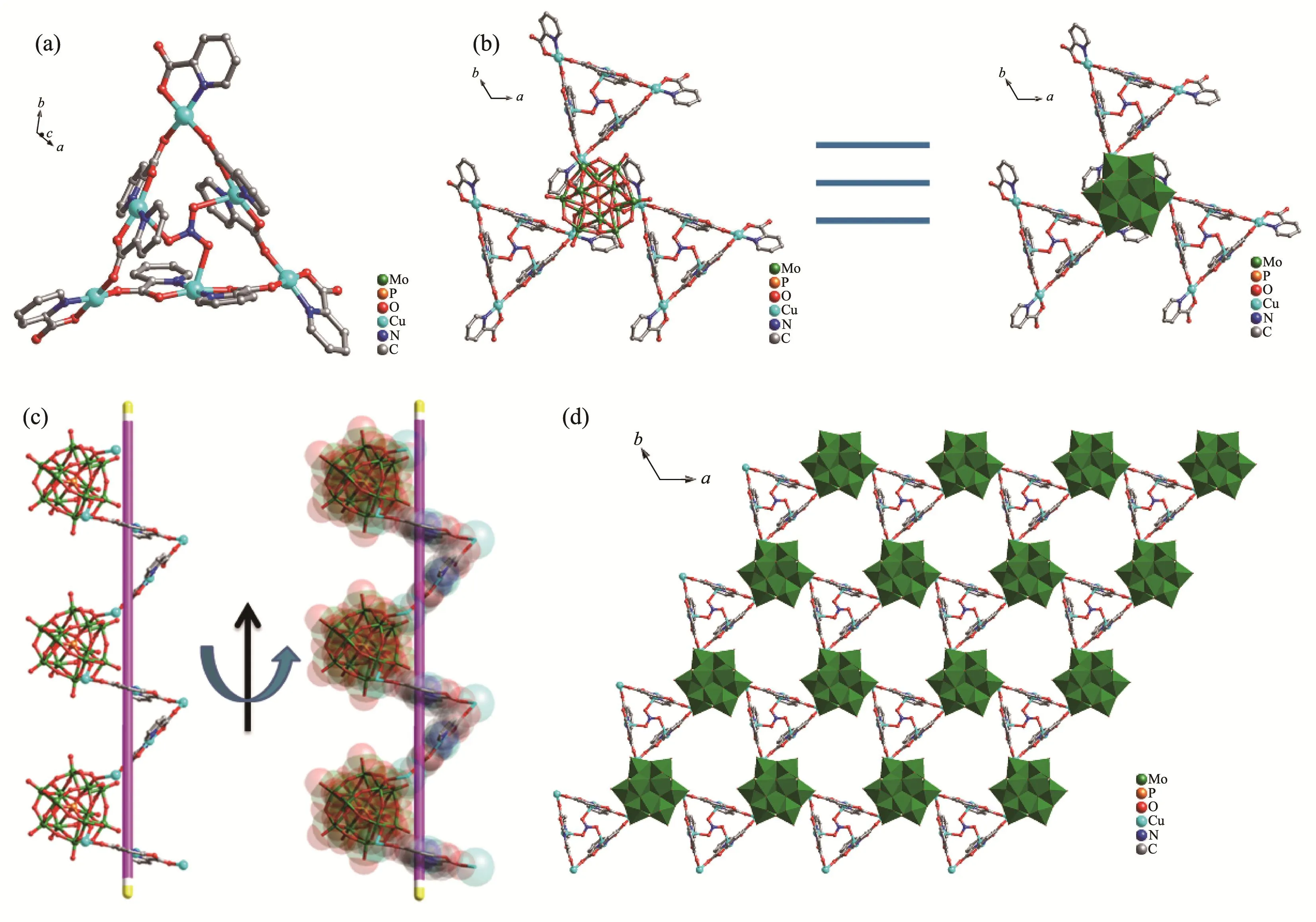
Fig.3 Structure of compound 2:(a)hexanuclear Cu cluster structure;(b)three-leaf fan structure;(c)right-handed helical chain;(d)two-dimensional packing structure
2.3 IR spectra and PXRD of compounds 1 and 2
In the IR spectra of compounds 1 and 2,a strong band at 1 643 cm-1(1)and 1 640 cm-1(2)can be attributed to the C=O stretching vibration of the carboxyl group.A broad band at 3 571 cm-1(1)and 3 448 cm-1(2)can be attributed to the characteristic O-H stretching vibration of carboxyl group.A band at 1 604 cm-1(1)and 1 604 cm-1(2)can be assigned to the coordinated pyridyl ring vibrations.As for compound 1,the bands at 924,886,794,534 cm-1can be assigned to the stretching vibration of Si-O,W-O and W-O-W in[SiW12O40]4-polyoxometalates anion(Fig.4a).For compound 2,the bands at 954,805 and 689 cm-1are characteristic absorption peaks of Mo-O,Mo-O-Mo and P-O(Fig.4b).
To test the phase purity of compounds 1 and 2,PXRD experiments were carried out(Fig.5).The diffraction peaks of both simulated and experimental patterns match well in the key positions,which indicate that the powders of these two compounds are single phase.The intensity differences may arise from the different orientation of samples.
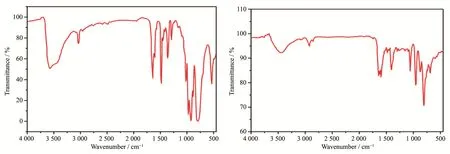
Fig.4 IR spectra of compounds(a)1 and(b)2
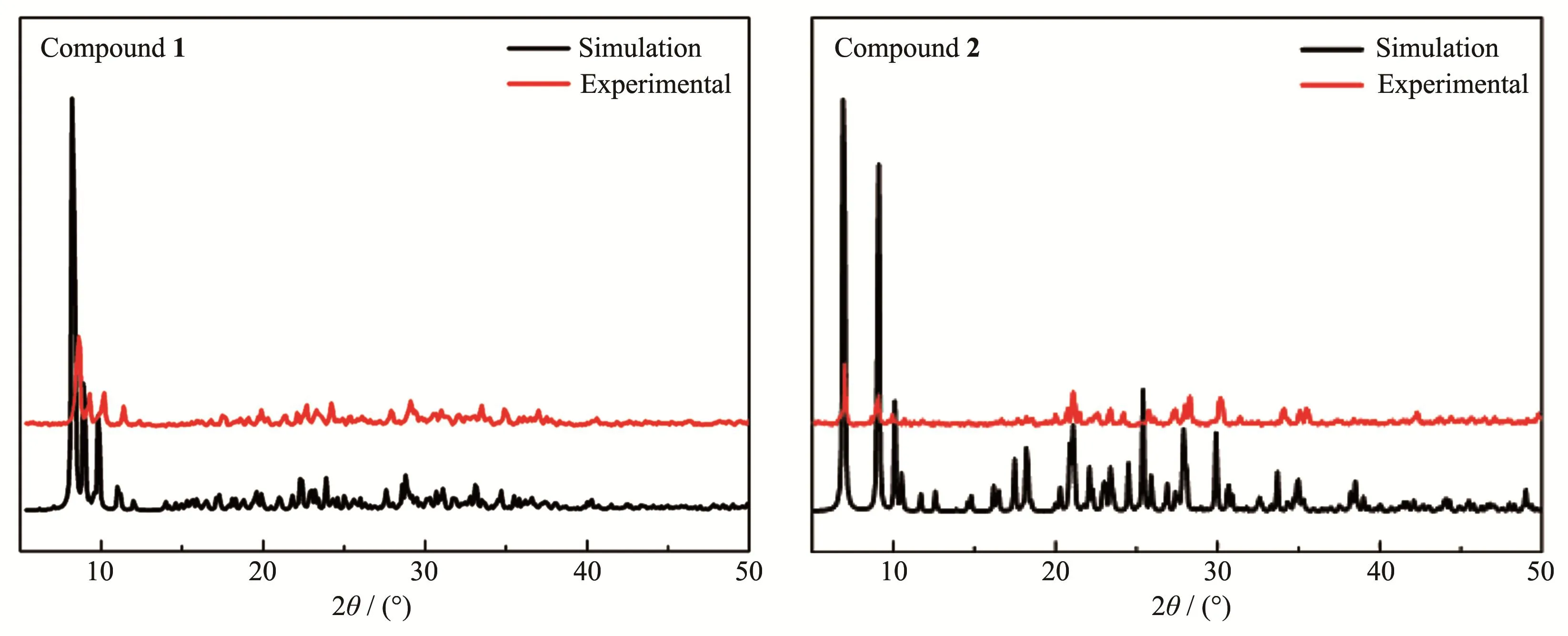
Fig.5 PXRD patterns of compounds 1 and 2
2.4 Electrochemical property of compound 1
We try to measure the electrochemical properties of compounds 1 and 2,but unfortunately,compound 2 is not stable in the electrolyte and there is no observable pattern for its cyclic voltammogram.So only the electrochemical property of compound 1 are reported here.When the sweep speed was 100 mV·s-1,in the potential range of-800~0 mV,the half-wave potentials(E1/2=(Ecp+Eap)/2)ofⅠ-Ⅰ′,Ⅱ-Ⅱ′and Ⅲ-Ⅲ′in compound 1 were-270,-516 and-708 mV,which can be attributed to electronic redox process of[SiW12O40]4-unit(Fig.6)[11].As the scanning rate increased,the cathode peak potentials of the compound 1 moved in the negative direction,and the corresponding anode peak potentials moved in the positive direction.

Fig.6 Cyclic voltammogram of 1-CPE(the bulk-modified carbon paste electrode)in 0.5 mol·L-1Na2SO4+0.1 mol·L-1H2SO4aqueous solution at different scan rates
3 Conclusions
In summary,using 2-picolinic acid as organic ligand,two inorganic-organic hybrid compounds containing Keggin-type polyoxometalates units were obtained.Apparently,taking advantage of hydrothermal method,different types of hybrid compounds could be fabricated in a feasible way.Interestingly,under strong acidic experimental condition(pH≈0.5)by using H3PO4/HNO3in the synthetic process of 2,[Mo7O24]6-unit has transformed to Keggin-type[PMo12O40]3-unit in the presence of PO43-ions.Undoubtedly,the choice of experimental conditions(pH,solvent,temperature,buffer solution,ionic strength,the sort of counter-cations and reducing agents,etc.)could play important role in the process of assembling final POMs clusters.It is anticipated that more interesting compounds with versatile structural characters could be obtained consistently.
